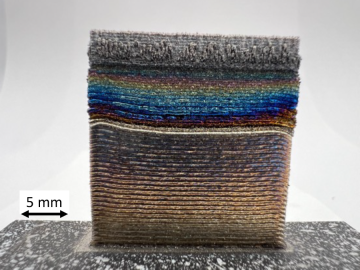
Filter News
Area of Research
- (-) Materials (76)
- (-) Neutron Science (32)
- Advanced Manufacturing (1)
- Biological Systems (1)
- Biology and Environment (56)
- Building Technologies (1)
- Clean Energy (63)
- Computational Engineering (1)
- Computer Science (2)
- Electricity and Smart Grid (1)
- Energy Sciences (1)
- Fuel Cycle Science and Technology (1)
- Fusion and Fission (19)
- Fusion Energy (3)
- Isotope Development and Production (1)
- Isotopes (15)
- Materials Characterization (2)
- Materials Under Extremes (1)
- National Security (26)
- Nuclear Science and Technology (2)
- Supercomputing (73)
News Topics
- 3-D Printing/Advanced Manufacturing (5)
- Advanced Reactors (1)
- Artificial Intelligence (1)
- Big Data (1)
- Bioenergy (2)
- Biology (1)
- Biomedical (2)
- Biotechnology (1)
- Buildings (3)
- Chemical Sciences (17)
- Clean Water (1)
- Climate Change (3)
- Composites (2)
- Computer Science (1)
- Coronavirus (2)
- Critical Materials (4)
- Decarbonization (5)
- Energy Storage (6)
- Environment (4)
- Fossil Energy (1)
- Fusion (2)
- Grid (2)
- High-Performance Computing (1)
- Irradiation (1)
- Isotopes (3)
- Machine Learning (1)
- Materials (43)
- Materials Science (8)
- Microscopy (3)
- Molten Salt (1)
- Nanotechnology (5)
- Net Zero (1)
- Neutron Science (27)
- Nuclear Energy (5)
- Partnerships (6)
- Physics (9)
- Polymers (4)
- Quantum Computing (2)
- Quantum Science (1)
- Renewable Energy (1)
- Space Exploration (1)
- Sustainable Energy (2)
- Transportation (3)
Media Contacts

After a highly lauded research campaign that successfully redesigned a hepatitis C drug into one of the leading drug treatments for COVID-19, scientists at ORNL are now turning their drug design approach toward cancer.

For more than half a century, the 1,000-foot-diameter spherical reflector dish at the Arecibo Observatory in Puerto Rico was the largest radio telescope in the world. Completed in 1963, the dish was built in a natural sinkhole, with the telescope’s feed antenna suspended 500 feet above the dish on a 1.8-million-pound steel platform. Three concrete towers and more than 4 miles of steel cables supported the platform.

Since its inception in 2010, the program bolsters national scientific discovery by supporting early career researchers in fields pertaining to the Office of Science.

Dean Pierce of ORNL and a research team led by ORNL’s Alex Plotkowski were honored by DOE’s Vehicle Technologies Office for development of novel high-performance alloys that can withstand extreme environments.

Xiao-Ying Yu, a distinguished scientist at the Department of Energy’s Oak Ridge National Laboratory, has been named a Fellow of AVS: Science and Technology of Materials, Interfaces, and Processing, formerly American Vacuum Society.

Research into a new, unique technology to fabricate composite metal parts for a wide range of applications operating in extreme environments across the aviation, space and energy industries is showing promise for additive manufacturing.

The Spallation Neutron Source at the Department of Energy's Oak Ridge National Laboratory set a world record when its particle accelerator beam operating power reached 1.7 megawatts, substantially improving on the facility’s original design capability.

Researchers at the Department of Energy’s Oak Ridge National Laboratory were the first to use neutron reflectometry to peer inside a working solid-state battery and monitor its electrochemistry.

Creating energy the way the sun and stars do — through nuclear fusion — is one of the grand challenges facing science and technology. What’s easy for the sun and its billions of relatives turns out to be particularly difficult on Earth.

Ken Herwig's scientific drive crystallized in his youth when he solved a tough algebra word problem in his head while tossing newspapers from his bicycle. He said the joy he felt in that moment as a teenager fueled his determination to conquer mathematical mysteries. And he did.


